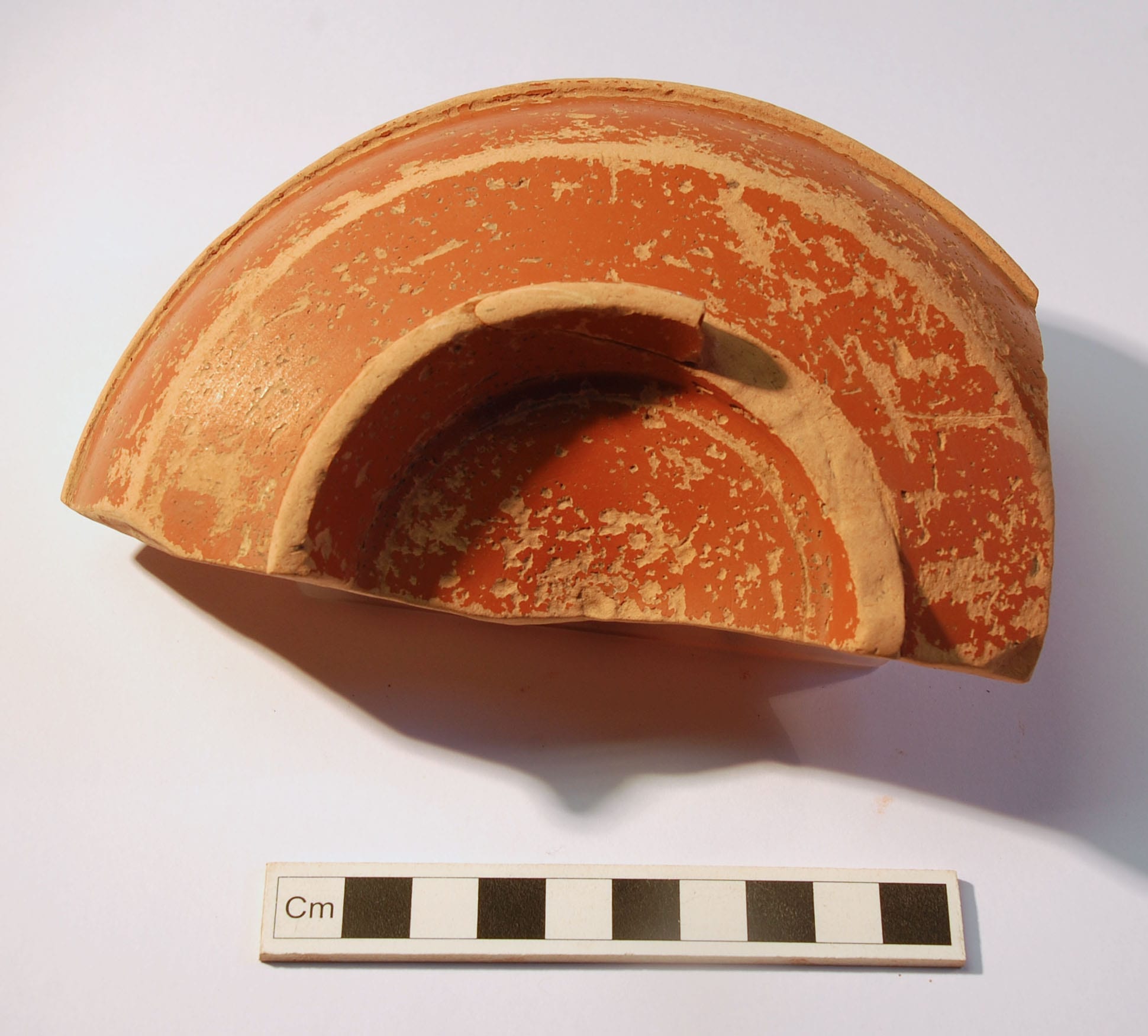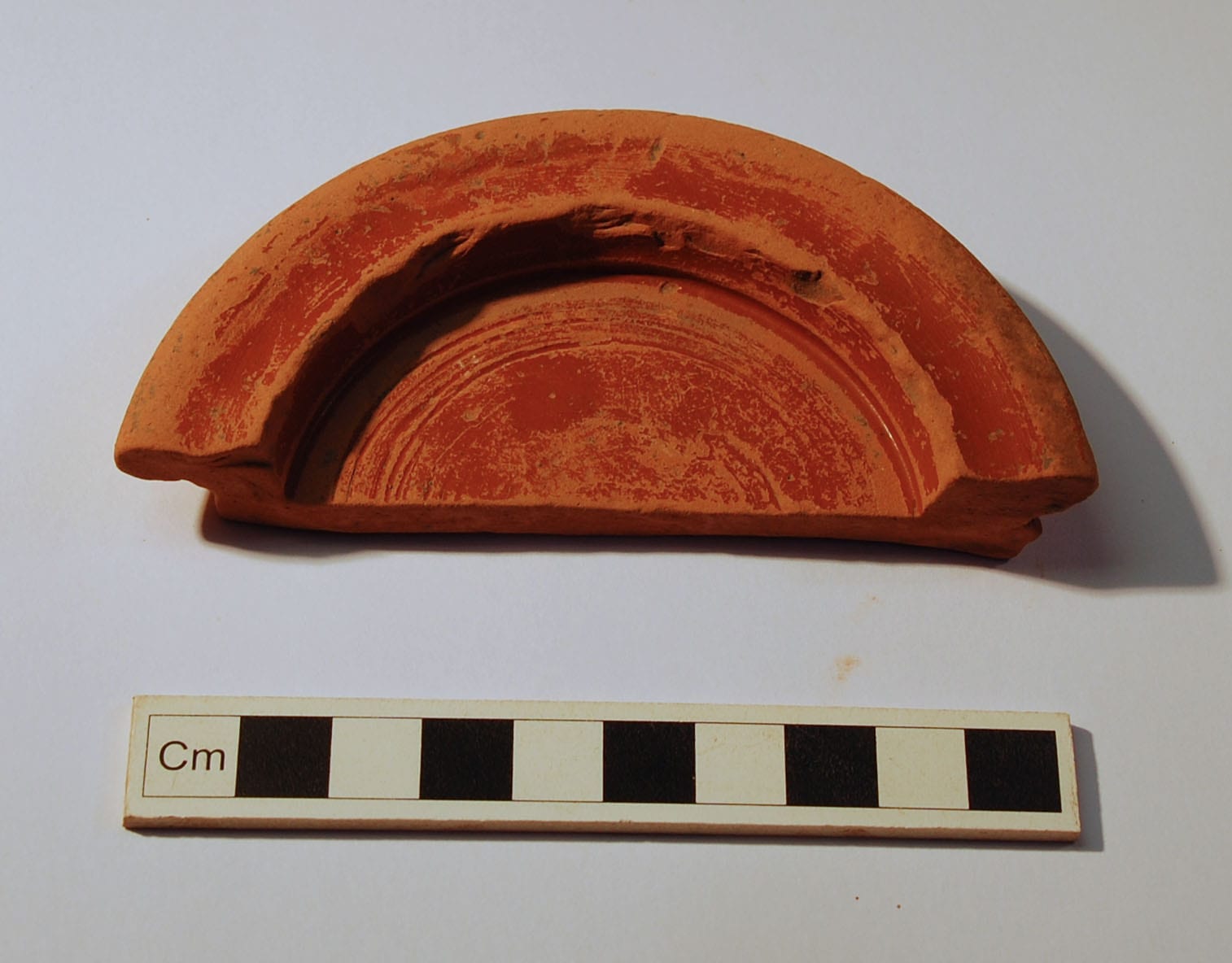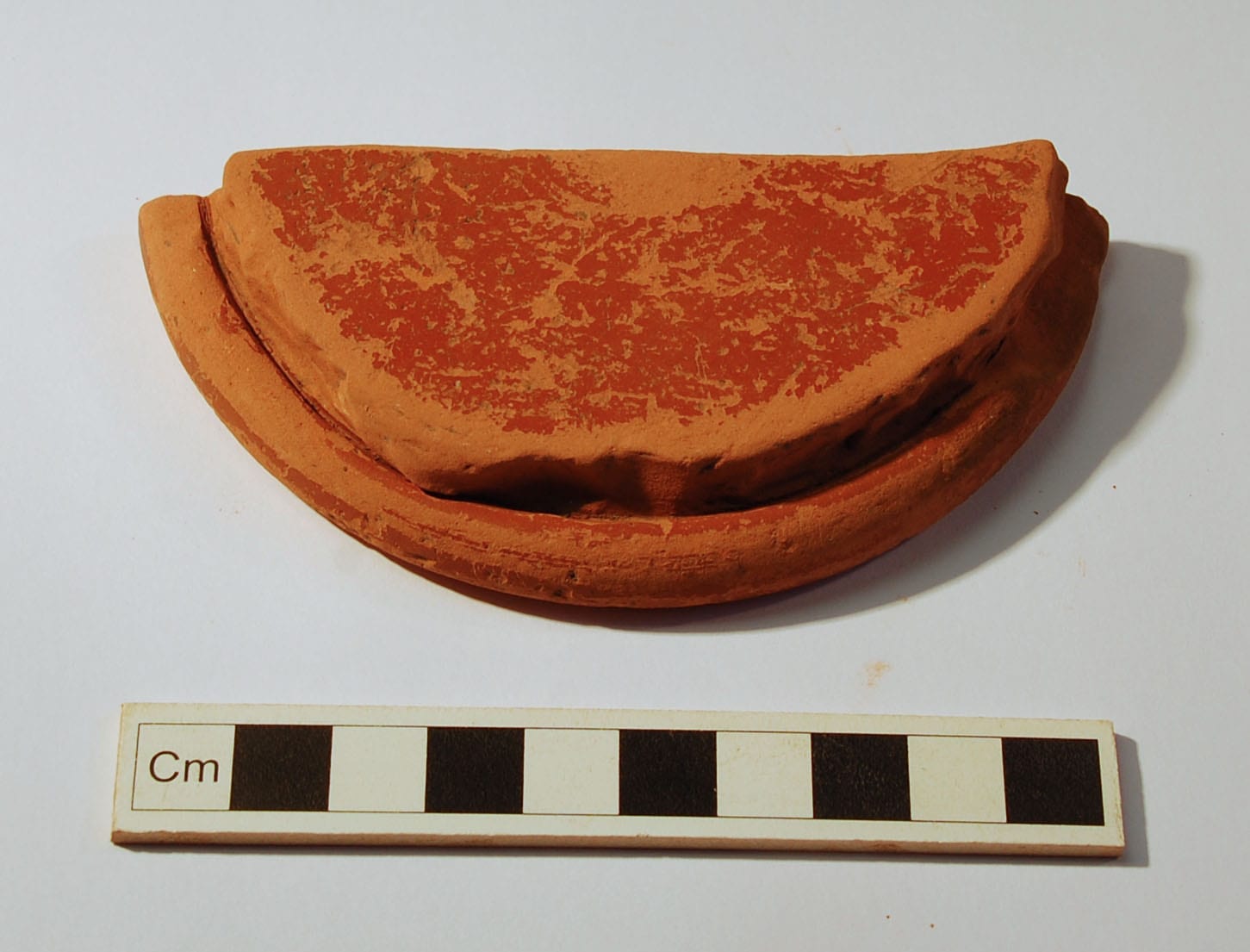DETAILED CATALOGUE OF SELECTED VESSELS
The individual vessels that are detailed below have been selected according to their intrinsic interest or significance to the site. Entries are listed in order of trench, phase and context, then by fabric, form and date. Amongst the moulded ware, figure-types as they appear on bowls are frequently smaller than Oswald’s illustrated types (see Dannell et al 1998, 71 and 87). Where this specific discrepancy occurs, it is not noted in the catalogue.
Trench 1
Phase 4
A single vessel:
(183)
1. South Gaulish moulded bowl form 37. S-shaped godroons (cf Dzwiza 2004, Abb 96. F4.3 at Pompeii) are set above a speckled boar (cf Nieto and Puig 2001, type Bc.8?) running over stalks. The basal wreath consisted of small but indistinct leaf-and-bud motifs. S-shaped godroons and animals running over stalks occur on a bowl form 37 at Cala Culip (Nieto and Puig 2001, 389 no 479) and a boar runs over stalks on other bowls there (ibidem, 404-405 nos 521-523). A date c AD 75-90 may be proposed for the Middlewich bowl. Two adjoining wallsherds, weight 24 g.
Phase 5
A single sherd:
(144)
2. South Gaulish moulded bowl form 29. A small fragment only from the beaded middle and lower zone with the edge only of a leaf, from a vessel produced in the period c AD 65-85 and most probably a Flavian product. Weight 2 g.
Phase 8
A single sherd:
(126)
3. Central Gaulish moulded bowl form 37. Ovolo above a guideline (usually said to be Rogers B52, but this bears greater similarities to B233; cf Rogers 1999, pl 89.8); below it, panels included a double medallion containing a smaller one (Rogers E17). All these motifs occur on a bowl from Corbridge (S & S pl 154.16), in the Pugnus-Secundus style. This “Secundus-ish” style is dated c AD 150-170 according to Rogers (1999, 206, 232) and c 150-180 according to the forthcoming Leeds index of potters’ stamps (the late Brian Hartley, pers comm). Rimsherd (2%), weight 14 g.
U/S
4. East Gaulish moulded bowl form 37. The decoration included, here, a large rosette (Ricken-Fischer O 37) in a plain medallion. This rosette was used at Rheinzabern by several potters from Ianus ii onwards. The general appearance of the sherd and it decorative composition may suggest a later potter such as Lupus (iv in the Leeds Index); see Ricken 1948, Taf 157.5-6. Lupus was an associate of Iulius and their association has been ascribed a date in the earlier-third century (c AD 210-235 for a piece in their style embedded in the late fort wall at Piercebridge; Ward 2008, D9, 15 no 2, Fig. D9.16 no. 1482008, forthcoming). Iulius (I) bowls occur in the Butzbach Steinkastell and at Pfünz as well as in a waster group at Rheinzabern, currently dated c 235-245 (Bittner 1986, 249-252 and in the second ‘shipment’ group at New Fresh Wharf, also dated c 235-245; see Bird 1986, 2.106). A date in the range c AD 200-240 should cover all the possibilities for the production date of this bowl. Weight 14 g.
Trench 4
Phase 7
None of the samian vessels represented could be dated firmly any later than the Hadrianic period.
(402)
5. South Gaulish moulded bowl form 37. A single sherd showing that distinctive ovolo with a long trident tip turned left which was used by a group of potters including Albanus iii, Amandus and Coii Bass[ Below, a pair of gladiators (Oswald type 1007 and 1008). The same gladiators occurred on a bowl from the Middlewich Faircloughs Homes site (Ward 2008, samian catalogue no 59), but that was produced earlier in the Flavian period and the gladiators on the Community Project site have degenerated. The main activity of the Albanus iii group of potters is considered to have continued from the 80s AD into the Trajanic period: c AD 85-110 perhaps. Weight 17 g.
(419)
6. Central Gaulish moulded bowl form 37 in an excellent ware. Above the basal line of the decoration lay a small leaf (Rogers H146) and a finely modelled mask (Oswald type 1329), used by the Lezoux potter Butrio. The same mask occurred on a bowl in the style of Butrio from the Faircloughs Homes site (Ward 2008, in print, samian catalogue no 75). c AD 120-145. Weight 2 g.
Trench 9
Phase 7
(908)
7. Central Gaulish moulded bowl form 37. Both sherds display the figure of Vulcan (Oswald 66) in panelling bordered by astragali (Rogers A9) infilled with tufts derived from the leaf or plume Rogers J178; broken at a cleat-type repair hole. This is the early style of Cinnamus or an associate working in his group in the period c AD 135-160; Vulcan is attested for Cerialis; cf S & S pl 164, Cerialis no 3; Simpson and Rogers 1969, 6 no 13, with the plume motifs. Two sherds: the rimsherd was unstratified in Tr 9; diameter 20 cm (8%), weight 43 g.
U/S
8. Central Gaulish moulded bowl form 37, from Les Martres-de-Veyre. Badly blurred ovolo Rogers B37 above coarse wavy-line border and an arcade containing the indistinct head of a figure. Style of Igocatus (X-4), c AD 100-120. Rimsherd of diameter 20 cm (8%). Weight 19 g.
9. Central Gaulish moulded bowl form 37, with smeared and botched decoration. The ovolo is Rogers B231 (Cinnamus’s so-called ‘small bowl’ ovolo), poorly moulded here, above panelling that included a large caryatid (Oswald type 1207 or 1207A) and an erotic scene (Oswald type H). This ovolo was used by various potters, including Cinnamus, Pugnus and the Large S Potter, potters who worked in the wide range c AD 125-180. This bowl looks likely to be Antonine and was most probably a product of Cinnamus’s firm in the period c AD 150-170. Weight 18 g.
Trench 12
Phase 7
(1284)
10. Central Gaulish moulded bowl form 37. Slightly indistinct ovolo (Rogers B47) above panelling that included a leafy festoon (Rogers F16) and (now abraded) figures: a caryatid (probably Oswald 1199) is set between a very large figure that must have overlapped the ovolo, and the front figure of an erotic group (Oswald type B). The motifs indicate the work of Criciro, who was active in the wide range c A D 135-170 but this bowl looks likely to have been produced in the late-Hadrianic or early-Antonine period (ie before c 160). Three adjoining sherds, rim diameter 20 cm (12%), weight 36 g.
Phase 7u
(1220)
11. South Gaulish moulded bowl form 37. A blurred stag (Nieto and Puig 2001, type Bb.18 or Bb.19) reclines between stylized, Germanus-type trees (op cit, nos 321-322) in which sits a large, indistinct bird as on Hofmann 1988, pl 16.125, Banassac. The Middlewich bowl appears to be a product of La Graufesenque probably in the period c 75-90. Weight 16 g; A second sherd from Phase 9m (1217) included the footring which was worn from use; weight 63 g.
Phase 8
(1210)
12. Central Gaulish moulded bowl form 37. The panelled decoration included a tripod (Rogers Q43), two small, crouching panthers (Oswald 1518 faces right) and the recurring figure of a small draped female (Oswald 939). The motifs point to the work of Cinnamus and Secundus; in either case the bowl was produced most probably in the period c AD 150-180. The footring is badly worn from use and an internal patch of wear probably represents intentional erasure of a graffito. The graffito had included a large cursive letter A that was incised in the lower wall/base but it has been partially erased.. Weight 81 g.
(1216)
13. Central Gaulish beaker form 72 with overall ‘cut-glass’ decoration, produced in the second half of the second century. 4 fragments and a 5 rimsherd of diameter 7 cm (20%); weight 12 g.
(1223)
14. South Gaulish indeterminate form. There is a small fragment of a basal stamp, C[ or O[ or ]O by a potter working at La Graufesenque within the range c AD 70-110, weight 4 g.
15. Central Gaulish moulded bowl form 37. Ovolo (Rogers B7, but with a detailed rosette-tip to the tongue, above indistinct scrolls (probably Rogers M10 and M11, see Romeuf 2000, 333 no 5 and, with ovolo B7, 334 no 7). Infilling motifs: small animals including goats Oswald 1836, Rogers 1999, R.4016; birds (Oswald 2279 and 2315A) and cupids (Oswald 405 and 424). The bifid wreath consisted of rams’ horns (Rogers G370, indistinct here. This represents the work of Potter X-13 at Les Martres-de-Veyre; c AD 110-125. An unusual bowl at the Faircloughs Homes site (Ward 2008, samian catalogue no 35) probably displays the same ovolo and that bowl probably also represented X-13 rather than the Potter of the Rosette as identified by Terrisse (1968, pl 19.371). Seven pieces, constituting the complete profile of the vessel, whose footring shows wear from use. Rim diameter 21 cm (81%), weight 577 g.
16. Central Gaulish moulded bowl form 37. A fragment of a large, winding scroll with a large leaf (Rogers H58); H58 was used by the potter Attianus, c AD 125-145. Weight 18 g.
(1232)
17. South Gaulish indeterminate form, perhaps from the plain band of a moulded bowl form 37 and produced in the range c AD 70-110, but this is a mere fragment. It has been re-worked as a tiny counter of diameter 13mm; weight 1g.
18. Central Gaulish moulded bowl form 37, produced at some point in the range c AD 120-160. Rim of a very large bowl and an adjoining sherd: the plain band displays repair-work with round rivet-holes that retain their lead rivets; the exterior has been badly abraded and scored, perhaps accidentally, around the rivet-holes. Rim diameter 26 cm (12%), weight 55 g.
(1282)
19. South Gaulish cup form 27, produced in the range c A D 70-110. This wallsherd appears to have been cut down between the vessels curves: there were tool-marks that had evidently been made in the fabric before natural erosion occurred. Weight 12 g.
20. Central Gaulish dish form 18/31, produced at Lezoux c AD 120-145/150. Two pieces, one the complete profile of the vessel and the other an adjoining chip from the foot. This is vessel has been badly battered, apparently during use. The basal stamp has been abraded, probably scrubbed, away but may have begun or ended O[ or ]O The standing surface of the footring has been worn away totally during use, as also the rim and the external junction of the wall and base. The internal and external surfaces of the vessel are also badly chipped, pitted and scratched. The fabric is fairly soft and, even allowing for explosion out of small particles, small marks made through the surface gloss indicate short, sharp stabs by a sharp tool and there are occasional, tiny circular puncture marks. Whatever its final function may have been, this dish has clearly been treated badly and it can hardly have finished its life as fine tableware, Rim diameter 17 cm (38%), weight 176 g.
Samian Catalogue Number 20: Central Gaulish Dish | Click images to enlarge |
The evidence of the other three vessels in context (1282) may be significant. They were:
21. South Gaulish indeterminate form, c AD 70-110. A small flake from the base or lower wall. Weight 2 g.
22. Central Gaulish dish form 18/31 c AD 120-150. The footring was worn from use and the fabric seems to have been slightly stained after breakage. Weight 43 g.
23. Central Gaulish flanged bowl form 38. Probably from les Martres-de-Veyre, but at any rate produced in the period c AD130-160. Rim and flange: both the top of the flange and the upper internal wall are scratched, possibly in use but this is not certain. Rim diameter 17cm (6 %), weight 87 g.
(1289)
24. South Gaulish cup form Ritterling 8. This form is almost exclusively pre-Flavian and this vessel is most likely to have been produced in the range c AD 55-70. The footring was very worn from use. Weight 20 g.
25. South Gaulish dish form 15/17 or 18. The basal stamp reads OF?CEN This was a stamp of the potter, Censor i, who worked at La Graufesenque. Another of his stamps, die 3c, reading OFCEN (Polak 2000, pl. 7, C126) was found at the Fairclough Homes site, dated c AD 70-90 on form 18R. However, the item under discussion is more likely to represent Die 3b, reading OF?CEN and noted twice at Holt; see Dickinson in Ward 1998, 65 nos 6-7, where it was dated c AD 70-95. The footring, deeply grooved inside, was very worn from use; it again exhibits much scratching on top of the base, though this may have been accidental. It was also burnt. Weight 33 g.
Phase 8u
(1231)
26. South Gaulish cup form 27. The basal stamp is battered but reads perhaps IVL??I with retrograde L? It is likely to represent a so-called ‘illiterate’ potter. The developed form of this cup with its heavy footring may suggest production in the period c AD 80-110. Complete profile of the vessel, whose footring was considerably worn in use. Rim diameter 14 cm (3%); weight 55 g.
27. Central Gaulish moulded bowl form 37 with a botched ovolo (Rogers B102) above figured panelling whose borders had a small rosette terminal. The main figure here is that of a triton, a sea-monster wielding what looks like a baseball bat here, was in fact a club (Oswald 19). B102 is recorded for Advocisus, the associated potters Priscus and Clemens, and Potter P-19; the triton was used by Priscus and Clemens and suggests their work at Lezoux in the period c AD 160-200. Rim of diameter 22 cm (7%), weight 32 g.
Phase 9m
(1217)
28. Central Gaulish dish form 18/31. Basal stamp DACO[MA]RI or DAGO[MA]RI by Dagomarus at Lezoux. This was one of those potters who moved from Les Martre-de-Veyre; another of his Lezoux stamps, Die 13a, was recorded in the Chester fortress at the Crook St 1973-4 excavations. c AD 120/125-140. The footring was very worn from use and there is a fragment only of a graffito ]N or M[ incised below the base within the foot . Weight 81 g.
29. Central Gaulish cup form 33, most probably produced in the range c AD 120-160. The external wall of this sherd displays a fragment of graffito, that may have been erased. Weight 11 g.
29a Central Gaulish moulded bowl form 37. The indistinct ovolo may well have been Rogers B144 rather than B143, above a horizontal astragaloid border A9 and panels including a small gladiator (Oswald 1059) in a single medallion and Victory (Oswald 819A). This probably represents the early style of the Cinnamus group; cf Simpson and Rogers 1969, 8 no 19, c AD 135-160. A rimsherd (3%), weight 17 g from the same bowl as a sherd in Phase 12 (1213), weighing 21 g.
Phase 12
(1204)
30. Central Gaulish indeterminate form, produced at some point in the range c AD 120-200. A badly battered flake from a basal sherd which was re-worked as a disc of diameter approximately 45mm, worn around the circumference. Weight 4 g.
(1212)
31. Central Gaulish moulded bowl form 37, produced at some point in the Antonine period (c AD 140-200). The heavy footring shows much wear from use on its standing surface. It was later hacked off from the main body of the vessel and shows wear not only inside the base but also below it inside the foot. This piece appears to have been re-used upside-down, presumably as a mixing-palette. Weight 69 g.
Samian Catalogue Number 32: Footring of Central Gaulish moulded bowl | Click images to enlarge |
(1213)
32. Central Gaulish moulded bowl form 37. Large gladiators (Oswald 1001 and 1002) and a small figure (S & S 150, fig 18.12), as on a bowl from Holt (Grimes 1930, fig 45.117; S & S pl 76.32), in the style of the Large S Potter. Another (repaired) bowl in the style of this potter was found at the Faircloughs Homes site (Ward 2008, samian catalogue no 37. c AD 120-145. Two sherds including the rim, diameter 19 cm (4 %), weight 53 g.




